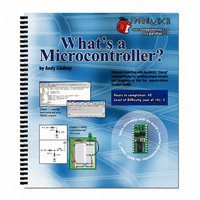28123 Parallax Inc, 28123 Datasheet - Page 327

28123
Manufacturer Part Number
28123
Description
TEXT WHAT'S A MICROCONTROLLER
Manufacturer
Parallax Inc
Type
Programmingr
Datasheet
1.28123.pdf
(340 pages)
Specifications of 28123
Style
Book
Title
What's a Microcontroller?
Contents
Whats a Microcontroller? Text
Product
Microcontroller Accessories
Core Processor
PIC16C57c
Flash
128 Bytes
Operating Supply Voltage
9 V
Board Size
31 mm x 16 mm
Lead Free Status / RoHS Status
Not applicable / Not applicable
- Current page: 327 of 340
- Download datasheet (6Mb)
Example Calculation: One Circuit, Two Circuits
Calculating how much current an LED circuit draws takes two steps:
Figure F-2 shows how to figure out the voltage across the resistor. The voltage supplied
is on the left; it’s 5 V. The voltages used are on the right. The voltage we don’t know at
the start is V
the LED is 1.6 V (the diode forward voltage). We also know that the voltage across the
parts has to add up to 5 V because of Kirchoff’s Voltage Law. The difference between 5
V and 1.6 V is 3.4 V, so that must be the voltage across the resistor V
1. Figure out the voltage across the resistor
2. Use Ohm’s Law to figure out the current through the resistor.
Vdd – Vss = 5 V The voltage (electrical pressure) from Vdd to Vss is 5 V. This is called
regulated voltage, and it works about the same as a battery that is exactly 5 V.
Vin – Vss = 9 V If you are using 9 V battery, the voltage from Vin to Vss is 9 V. Be careful.
If you are using a voltage regulator that plugs into the wall, even if it says 9 V, it could go as
high as 18 V.
Ground and/or reference refer to the negative terminal of a circuit. When it comes to the
BASIC Stamp and Board of Education, Vss is considered the ground reference. It is zero
volts, and if you are using a 9 V battery, it is that battery’s negative terminal. The battery’s
positive terminal is 9 V. Vdd is 5 V (above the Vss reference of 0 V), and it is a special
voltage made by a voltage regulator chip to supply the BASIC Stamp with power.
Ohm’s Law: V = I × R The voltage measured across a resistor’s terminals (V) equals the
current passing through the resistor (I) times the resistor’s resistance (R).
Diode Forward Voltage: When an LED is emitting light, the voltage measured from anode
to cathode will be around 1.6 V. Regardless of whether the current passing through it is a
large or a small value, the voltage will continue to be approximately 1.6 V.
Kirchoff’s Voltage Law Simplified: voltage used equals voltage supplied. If you supply
a circuit with 5 V, the number of volts all the parts use had better add up to 5 V.
Kirchoff’s Current Law Simplified: current in equals current out.
enters an LED circuit from Vdd is the same amount of current that leaves it through Vss.
Also, if you connect three LEDs to the BASIC Stamp, and each LED circuit draws 5 mA, it
means the BASIC Stamp has to supply all the circuits with a total of 15 mA.
R
, the voltage across the resistor. But, we do know that the voltage across
R
.
The current that
Related parts for 28123
Image
Part Number
Description
Manufacturer
Datasheet
Request
R

Part Number:
Description:
Microcontroller Modules & Accessories DISCONTINUED BY PARALLAX
Manufacturer:
Parallax Inc

Part Number:
Description:
BOOK UNDERSTANDING SIGNALS
Manufacturer:
Parallax Inc
Datasheet:

Part Number:
Description:
COMPETITION RING FOR SUMOBOT
Manufacturer:
Parallax Inc
Datasheet:

Part Number:
Description:
TEXT INFRARED REMOTE FOR BOE-BOT
Manufacturer:
Parallax Inc
Datasheet:

Part Number:
Description:
BOARD EXPERIMENT+LCD NX-1000
Manufacturer:
Parallax Inc
Datasheet:

Part Number:
Description:
CONTROLLER 16SERVO MOTOR CONTROL
Manufacturer:
Parallax Inc
Datasheet:

Part Number:
Description:
BASIC STAMP LOGIC ANALYZER
Manufacturer:
Parallax Inc
Datasheet:

Part Number:
Description:
IC MCU 2K FLASH 50MHZ SO-18
Manufacturer:
Parallax Inc
Datasheet:














